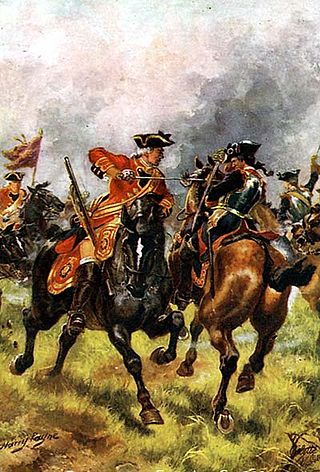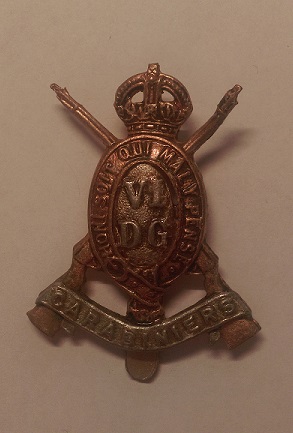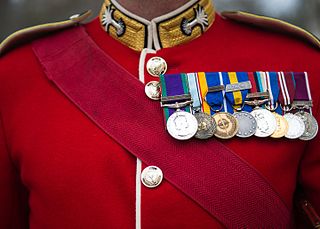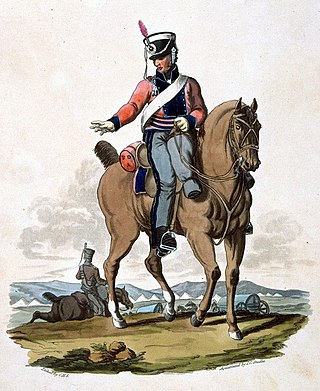
The British Army is the principal land warfare force of the United Kingdom, a part of the British Armed Forces along with the Royal Navy and the Royal Air Force. As of 1 October 2023, the British Army comprises 75,983 regular full-time personnel, 4,097 Gurkhas, 26,546 volunteer reserve personnel and 4,548 "other personnel", for a total of 111,174.

Dragoons were originally a class of mounted infantry, who used horses for mobility, but dismounted to fight on foot. From the early 17th century onward, dragoons were increasingly also employed as conventional cavalry and trained for combat with swords and firearms from horseback. While their use goes back to the late 16th century, dragoon regiments were established in most European armies during the 17th and early 18th centuries; they provided greater mobility than regular infantry but were far less expensive than cavalry.

The Royal Scots Greys was a cavalry regiment of the British Army from 1707 until 1971, when they amalgamated with the 3rd Carabiniers to form the Royal Scots Dragoon Guards.

The Royal Scots Dragoon Guards (Carabiniers and Greys) is a cavalry regiment of the British Army, and the senior Scottish regiment. The regiment, through the Royal Scots Greys, is the oldest surviving Cavalry Regiment of the Line in the British Army. The regiment is based at Waterloo Lines, Leuchars Station, as part of 51st Infantry Brigade and Headquarters Scotland, a light adaptable force brigade.

In the British Army, the Horse Guards comprised several independent troops raised initially on the three different establishments. In the late 1660s, there were thus three troops in England, one in Ireland, and two in Scotland of which one was ceremonial for attendance of Lord High Commissioner. In 1707, there were four troops of Horse Guards, and two troops of Horse Grenadiers.

Dragoon Guards is a designation that has been used to refer to certain heavy cavalry regiments in the British Army since the 18th century. While the Prussian and Russian armies of the same period included dragoon regiments among their respective Imperial Guards, different titles were applied to these units.

The Carabiniers (6th Dragoon Guards) was a cavalry regiment of the British Army. It was formed in 1685 as the Lord Lumley's Regiment of Horse. It was renamed as His Majesty's 1st Regiment of Carabiniers in 1740, the 3rd Regiment of Horse (Carabiniers) in 1756 and the 6th Regiment of Dragoon Guards in 1788. After two centuries of service, including the First World War, the regiment was amalgamated with the 3rd Dragoon Guards (Prince of Wales's) to form the 3rd/6th Dragoon Guards in 1922.

A Scottish regiment is any regiment that at some time in its history has or had a name that referred to Scotland or some part thereof, and adopted items of Scottish dress. These regiments were created after the Acts of Union in 1707 between England and Scotland, either directly serving Britain during its various wars, or as part of the military establishments of Commonwealth countries. Their "Scottishness" is no longer necessarily due to recruitment in Scotland nor any proportion of members of Scottish ancestry.

Red coat, also referred to as redcoat or scarlet tunic, is a military garment formerly much used by British infantrymen, so customarily that the term became a common synecdoche for the soldiers themselves.

The uniforms of the British Army currently exist in twelve categories ranging from ceremonial uniforms to combat dress. Uniforms in the British Army are specific to the regiment to which a soldier belongs. Full dress presents the most differentiation between units, and there are fewer regimental distinctions between ceremonial dress, service dress, barrack dress and combat dress, though a level of regimental distinction runs throughout.

Historically, Scotland has a long military tradition that predates the Act of Union with England. Its soldiers form part of the armed forces of the United Kingdom, more usually referred to domestically within Britain as the British Armed Forces.
Lieutenant-General William Kerr, 2nd Marquess of Lothian, was a Scottish peer who held a number of minor military and political offices. He was known by the courtesy title of Lord Newbattle until 1692, when he succeeded as Lord Jedburgh, then as Marquess of Lothian when his father died in 1703.

The English Army existed while England was an independent state and was at war with other states, but it was not until the Interregnum and the New Model Army that England acquired a peacetime professional standing army. At the Restoration of the monarchy, Charles II kept a small standing army, formed from elements of the Royalist army in exile and elements of the New Model Army, from which the most senior regular regiments of today's British Army can trace their antecedence. Likewise, Royal Marines can trace their origins back to the formation of the English Army's "Duke of York and Albany's maritime regiment of Foot" at the grounds of the Honourable Artillery Company on 28 October 1664.

The Horse Grenadier Guards, usually referred to as Horse Grenadiers, were a series of cavalry troops in the British Household Cavalry between 1687 and 1788, who used grenades and other explosives in battle. Originally attached to the Horse Guards, they became independent for a century before being disbanded. However, the men of the troops formed the basis of the new troops of Life Guards.
The Regiment of Horse was a cavalry unit active in Scotland in the late seventeenth century, which played an important role in the events of that period.

The 2nd Cavalry Brigade was a brigade of the British Army. It served in the Napoleonic Wars, the Boer War and in the First World War when it was assigned to the 1st Cavalry Division.

Warfare in early modern Scotland includes all forms of military activity in Scotland or by Scottish forces, between the adoption of new ideas of the Renaissance in the early sixteenth century and the military defeat of the Jacobite movement in the mid-eighteenth century.

A dragoon helmet is an ornate style of metal combat helmet featuring a tall crest; they were initially used by dragoons, but later by other types of heavy cavalry and some other military units. Originating in France in the second half of the 18th century, it was widely imitated by other European armies and was last used in combat in 1914. Some military units continue to wear this style of helmet for parades and other ceremonial duties.

The Cavalry Staff Corps was a unit formed during the Napoleonic Wars to keep discipline in the British Army. Consisting of four troops of cavalry, the corps was first raised in 1813 during the Peninsular War to deal with an excess of criminality and desertion in the Duke of Wellington's armies. It was disbanded after that campaign ended in 1814 but was reformed in 1815 during the Hundred Days campaign. The corps also served in the subsequent occupation of France. The unit was Britain's first standing military police force. A successor unit was raised for service in the Crimean War of 1853–1856 and a permanent military police was established in 1877.



















